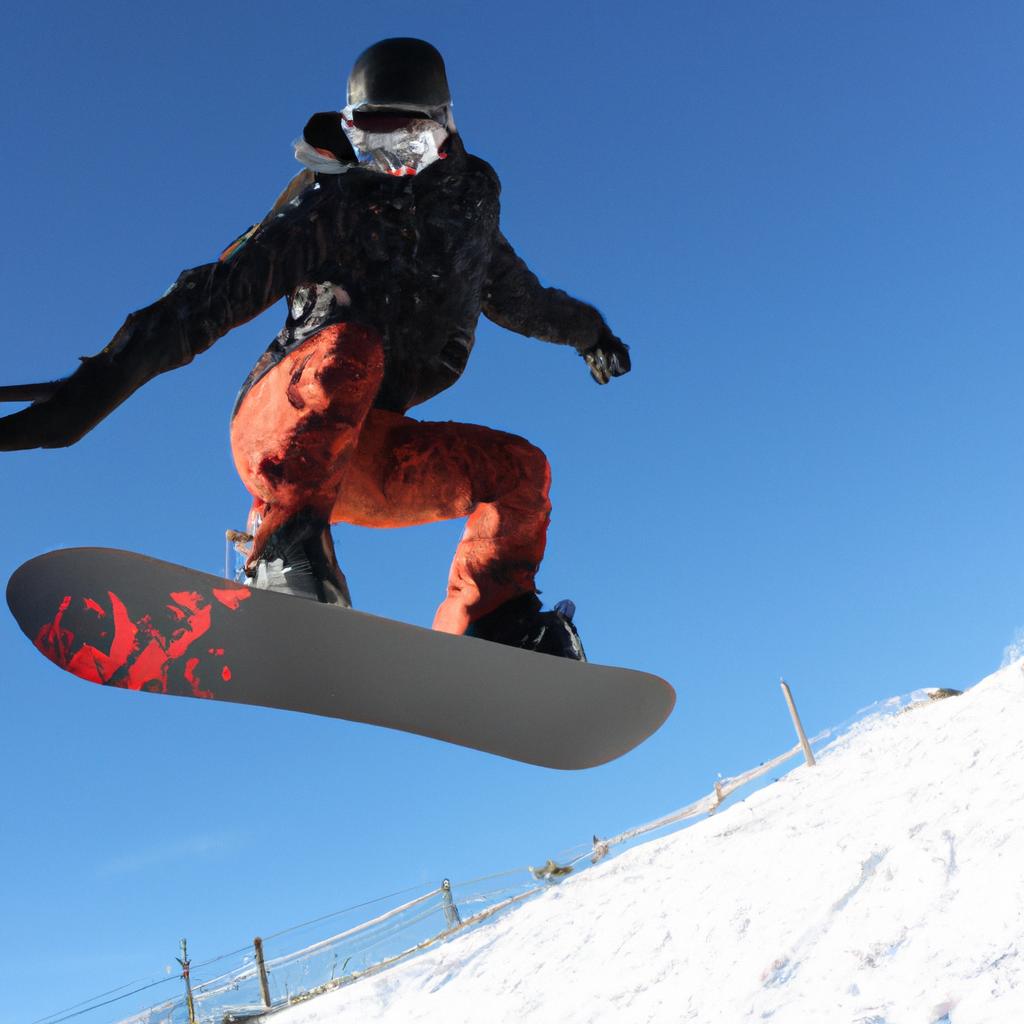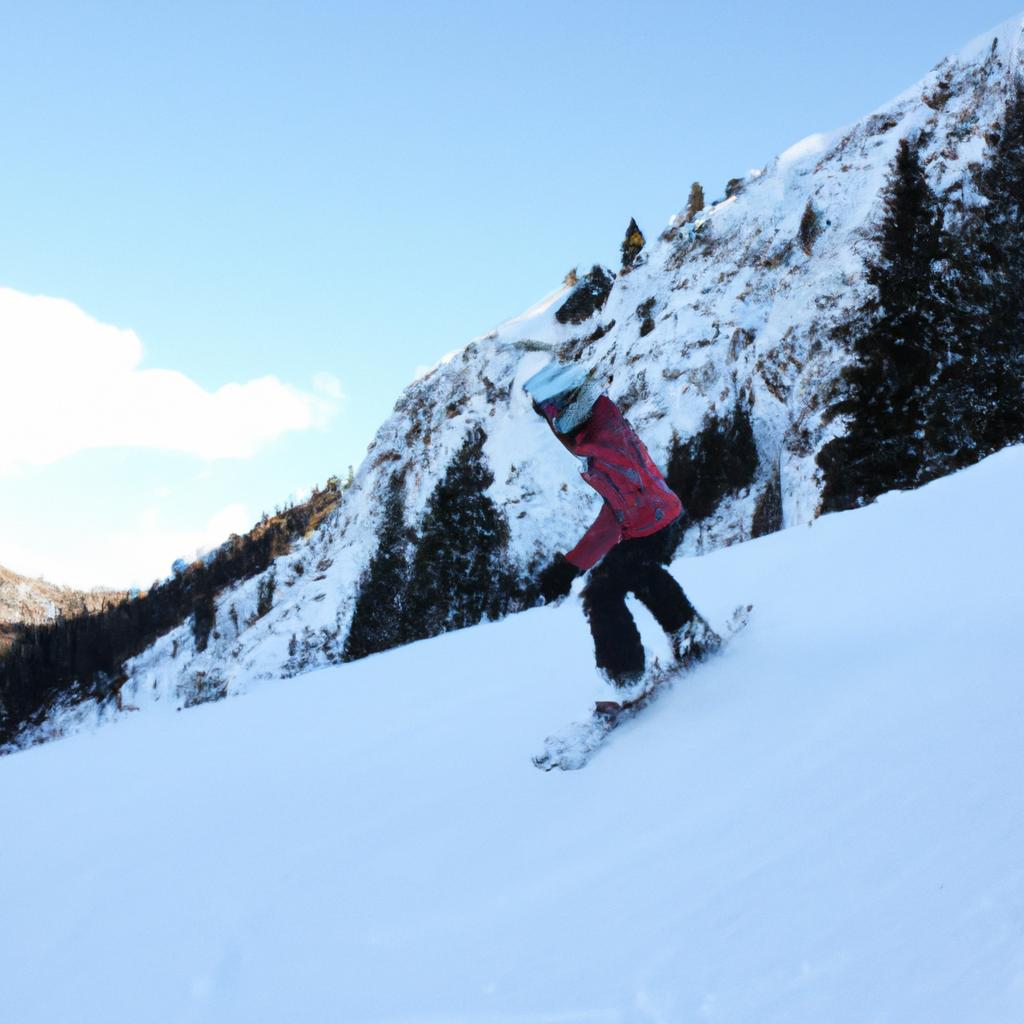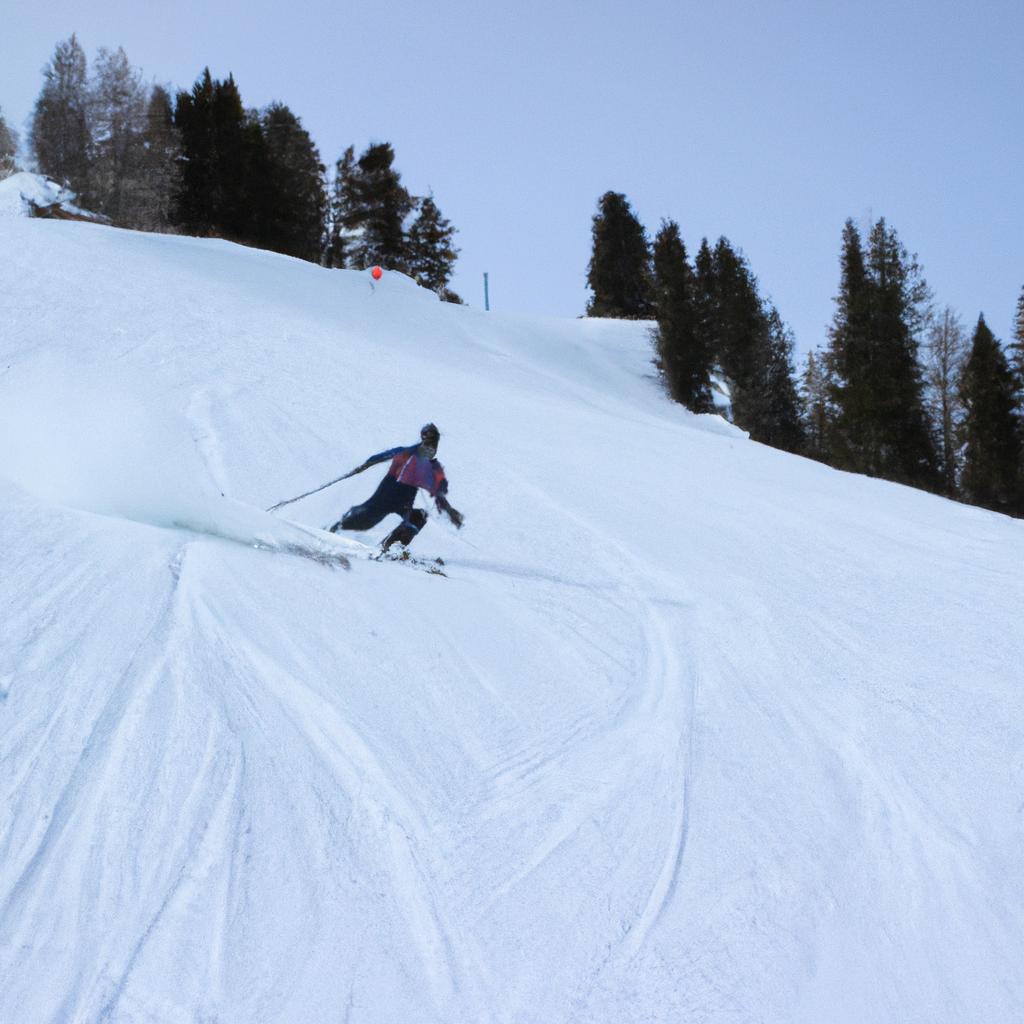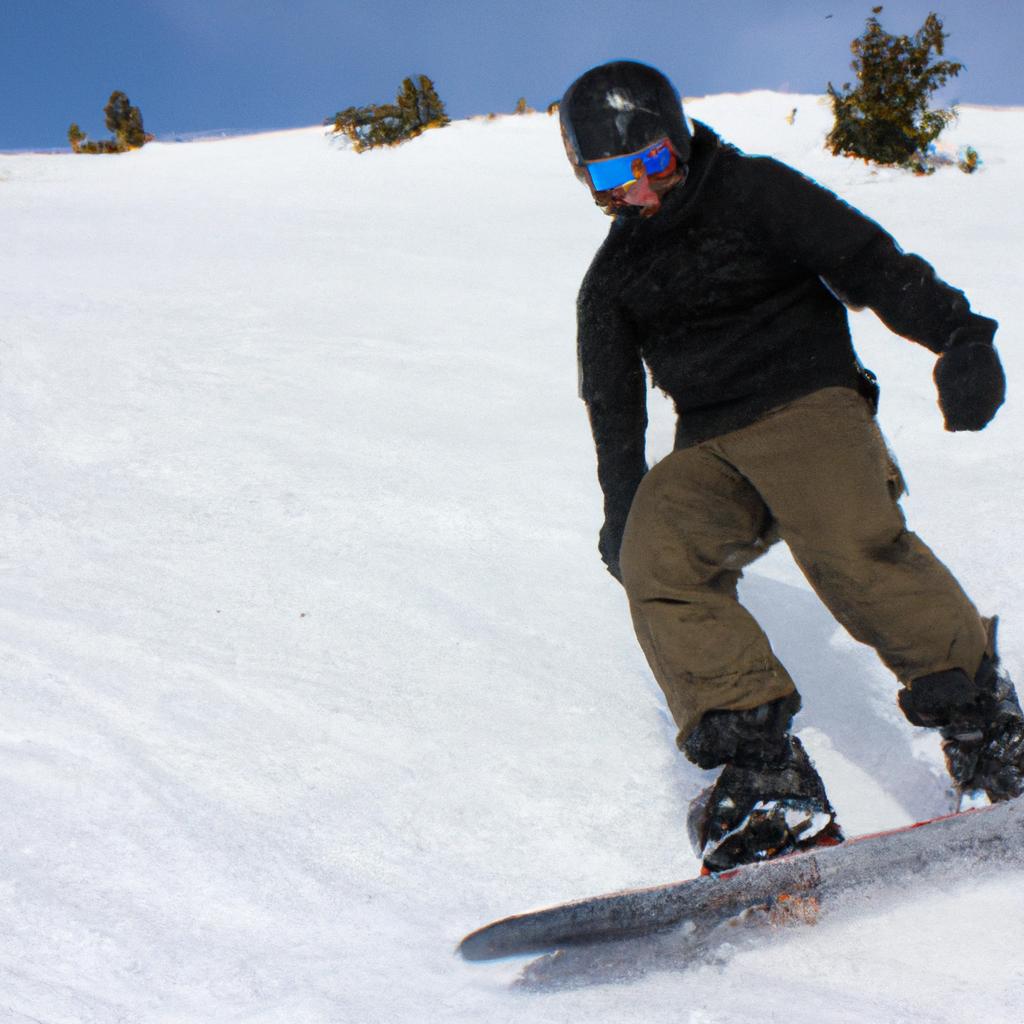Snowboarding is a popular and exhilarating winter sport that has gained significant attention over the years. From the early days of its inception, snowboarders have continuously pushed the boundaries of what is possible on a board sliding down a snowy slope. Mastering the art of shredding the snow requires not only physical strength and balance but also creativity and skill in performing various tricks.
For instance, imagine a skilled snowboarder effortlessly soaring through the air, executing complex rotations and flips with precision and control. This captivating display of athleticism exemplifies the mastery involved in snowboarding tricks. Whether it’s launching off massive jumps or maneuvering through rail slides, these tricks showcase the technical prowess and artistic expression inherent to this extreme sport.
In this article, we delve into the world of snowboarding tricks, exploring their history, techniques, and challenges. We will examine how riders progress from basic maneuvers to more advanced stunts while emphasizing safety precautions necessary for such high-risk activities. Through an academic lens, we aim to provide readers with insights into mastering the art of shredding the snow through intricate trickery. So strap on your boots and grab your board as we embark on this thrilling journey into the realm of snowboarding tricks.
Basic Snowboarding Tricks: Get started with fundamental tricks to build a strong foundation.
Basic Snowboarding Tricks: Get started with fundamental tricks to build a strong foundation.
Imagine yourself on top of a snow-covered mountain, strapped onto your snowboard, ready to embark on an exhilarating journey down the slopes. To fully immerse yourself in this thrilling experience and make the most out of your snowboarding adventure, it is essential to master some basic tricks that will provide you with a solid foundation. By honing these fundamental skills, you will not only enhance your performance but also ensure safety while shredding the snow.
To begin our exploration into the world of snowboarding tricks, let’s take a look at one example – the ollie. The ollie is considered as one of the core maneuvers in snowboarding and serves as a building block for many other tricks. This trick involves using both feet simultaneously to jump off the ground while maintaining control over the board mid-air. Mastering this move enables riders to overcome obstacles such as bumps or small jumps effortlessly.
Now that we have seen an example of a basic trick, let us delve deeper into what constitutes foundational knowledge when it comes to snowboarding. Here are four key aspects that every aspiring rider should focus on:
- Balance: Maintaining proper balance is crucial for executing various moves smoothly and effectively.
- Edge Control: Understanding how to manipulate edges allows riders to navigate different terrains confidently.
- Body Position: Learning correct body positioning ensures stability and facilitates seamless transitions between turns.
- Weight Distribution: Knowing how weight distribution affects maneuverability empowers riders to control their speed and direction efficiently.
Moreover, referring to Table 1 below, we can see specific examples of basic tricks categorized according to their difficulty level:
| Difficulty Level | Trick |
|---|---|
| Easy | Ollie |
| Nollie | |
| Medium | Boardslide |
| Butter | |
| Hard | 180° Spin |
| Nose/Tail Press |
Table 1: Examples of Basic Snowboarding Tricks
By familiarizing yourself with these foundational concepts and practicing the associated tricks, you will acquire essential skills that form the backbone of snowboarding expertise. This knowledge serves as a solid base on which you can build more advanced maneuvers to take your riding skills to new heights.
Transitioning into the next section about intermediate snowboarding tricks, we will explore a range of more challenging maneuvers designed for riders seeking further progression in their abilities. With the fundamental tricks mastered, it is time to embrace greater challenges and expand your repertoire of snowboarding techniques.
Now let’s dive into Intermediate Snowboarding Tricks: Take your skills to the next level with more challenging maneuvers.
Intermediate Snowboarding Tricks: Take your skills to the next level with more challenging maneuvers.
Transitioning smoothly from the previous section on basic snowboarding tricks, let’s now delve into the realm of intermediate snowboarding maneuvers. To illustrate this progression, consider the case of Alex, an aspiring snowboarder who has mastered fundamental tricks such as carving and ollies. Now, Alex seeks to elevate their skills by exploring more challenging techniques.
One example of an intermediate trick is the 180-degree spin. Imagine Alex effortlessly launching off a jump, swiftly rotating in mid-air while maintaining balance and control before gracefully landing back on the slope. This maneuver requires not only physical agility but also mental focus to execute with precision.
To continue building your repertoire of intermediate snowboarding tricks, here are some key concepts to explore:
- Grab Tricks: These involve reaching down and grabbing different parts of your board or bindings during jumps or spins. Not only do they add style to your riding, but they also enhance stability and control.
- Rails and Boxes: Mastering rail slides and box grinds will allow you to navigate obstacles placed along the slopes. This opens up new possibilities for creativity as you incorporate these features into your runs.
- Buttering: Also known as pressuring or flexing the board, buttering involves manipulating weight distribution to create unique movements that blend spinning and pressing into one smooth motion.
- Switch Riding: Transitioning seamlessly between regular (leading with left foot forward) and switch (leading with right foot forward) stances enhances versatility and adaptability on any terrain.
As you progress through these intermediate techniques, it’s important to remember that practice makes perfect. Take advantage of opportunities to refine your skills both on groomed trails and in freestyle parks.
With confidence gained from mastering these intermediate tricks, you’re ready to push yourself further by exploring advanced snowboarding maneuvers that will impress others on the slopes. So buckle up and get ready for even more thrilling challenges ahead!
[Table]
Advanced Snowboarding Tricks
| Trick Category | Description |
|---|---|
| Spins | Execute complex spins, such as the 540 or 720, with precision and style. |
| Inverts | Defy gravity by performing flips and rotations while airborne. |
| Grabs and Tweaks | Combine stylish grabs with tweaks to add flair to your tricks. |
| Rail Tricks | Navigate intricate rail setups with technical proficiency. |
[Table]
Now that you have a taste of what lies ahead in advanced snowboarding tricks, let’s dive into the next section where we will explore these exhilarating maneuvers further.
Advanced Snowboarding Tricks: Push your limits and master complex tricks that will impress others on the slopes.
To truly dominate on the slopes and leave others in awe, it’s time to delve into advanced snowboarding tricks. These maneuvers require a high level of technical skill, precision, and fearlessness. Let’s explore one such trick that exemplifies this level of expertise.
Imagine yourself standing at the top of a steep slope, ready to tackle an intimidating double black diamond trail. You take a deep breath, gather your courage, and launch yourself down the mountain with speed and determination. As you gain momentum, you spot the perfect opportunity for a jaw-dropping move – the backside 720 spin.
The backside 720 spin is a complex trick that involves rotating your body two full revolutions while airborne. It requires exceptional balance, spatial awareness, and control over your board. Executing this move successfully not only showcases your mastery of aerial maneuvers but also demonstrates your ability to land safely after completing multiple rotations.
When attempting advanced snowboarding tricks like the backside 720 spin or other equally challenging maneuvers, keep these key points in mind:
- Develop a strong core: A solid core provides stability during spins and flips.
- Perfect your edge control: Precise edge control allows for smooth transitions between rotations.
- Build up lower body strength: Strong legs contribute to powerful jumps and stable landings.
- Practice regularly: Consistent practice hones muscle memory and refines technique.
Embracing these principles will enable you to push beyond your limits and unlock new levels of performance on the slopes. Remember to always prioritize safety by wearing appropriate protective gear and gradually progressing from simpler tricks before attempting more advanced ones.
As you continue honing your skills through dedication and perseverance, freestyle snowboarding beckons as the next frontier to conquer. In our upcoming section on “Freestyle Snowboarding Tricks,” we’ll delve into the exciting world of performing tricks in terrain parks. Get ready to unleash your creativity and explore a whole new dimension of snowboarding mastery.
Section transition: Now, let’s dive into the world of freestyle snowboarding and discover tricks that will elevate your riding experience in terrain parks.
Freestyle Snowboarding Tricks: Explore the world of freestyle snowboarding and learn tricks to perform in the terrain park.
Transitioning smoothly from advanced snowboarding tricks, let’s now delve into the exciting world of freestyle snowboarding. In this section, we will explore various tricks that you can perform in the terrain park to showcase your style and creativity on the slopes.
Imagine yourself carving through freshly fallen powder, effortlessly gliding down the mountain. As you approach a jump, you gather speed and launch into the air with a perfectly executed backflip. The exhilaration of defying gravity and landing smoothly is unmatched, leaving both you and those watching in awe.
To help you navigate the realm of freestyle snowboarding, here are some essential tips:
- Timing and Control: Achieving proper timing is crucial when executing tricks. It allows you to maximize height and control your movements mid-air. Practice syncing your body movements with the natural rhythm of each trick.
- Body Positioning: Maintaining balance and stability while performing tricks requires mindful body positioning. Keep your knees slightly bent, shoulders aligned with your board, and focus on maintaining a centered stance throughout each maneuver.
- Progression: Freestyle snowboarding involves gradually building up skills by mastering simpler tricks before attempting more complex ones. This step-by-step progression helps minimize risks and ensures steady improvement over time.
- Safety Gear: Always wear appropriate safety gear such as helmets, wrist guards, knee pads, and elbow pads when engaging in freestyle snowboarding activities. These protective measures provide an added layer of security against potential injuries.
Here is an example table showcasing different freestyle snowboarding tricks along with their difficulty levels:
| Trick | Difficulty Level |
|---|---|
| 360 Spin | Beginner |
| Frontside Grab | Intermediate |
| Backside Rodeo | Advanced |
| Double Cork 1080 | Expert |
As you venture further into the world of freestyle snowboarding, remember to challenge yourself while prioritizing safety at all times. Get ready to take your snowboarding skills to new heights!
Now let’s explore Rail and Box Tricks – discovering techniques for riding and executing tricks on rails and boxes.
Rail and Box Tricks: Discover techniques for riding and executing tricks on rails and boxes.
Transitioning from the exciting world of freestyle snowboarding tricks, let us now delve into the realm of rail and box tricks. These are essential skills to master for riders looking to add creativity and technicality to their repertoire. To illustrate the importance of these tricks, consider a hypothetical scenario where a young snowboarder named Alex desires to compete in slopestyle competitions. In order to impress judges and secure a high score, Alex must possess proficiency in executing rail and box tricks with finesse.
The mastery of rail and box tricks requires not only physical dexterity but also an understanding of proper technique. Here are some key points to keep in mind when tackling rails and boxes:
- Balance: Maintaining balance is crucial while sliding along narrow surfaces or landing on boxes. Distribution of weight should be centered over the board, allowing for stability throughout the trick.
- Approach: A controlled approach towards the feature is vital for setting up successful rail or box slides. Riders should align themselves parallel with the obstacle before initiating their trick, ensuring they enter smoothly and maintain momentum.
- Body Positioning: Proper body positioning plays a significant role in performing rail and box tricks effectively. Keeping knees slightly bent helps absorb impact upon landing, while maintaining an upright posture aids in distributing weight evenly across the board.
- Confidence: Building confidence in one’s abilities is imperative when attempting more challenging rail or box features. Trusting one’s skills will enable riders to commit fully to their tricks, resulting in smoother execution.
To further emphasize the thrill that comes with mastering rail and box tricks, consider this emotional response evoked by witnessing such feats:
- As riders glide effortlessly down a metal handrail, spectators hold their breaths in anticipation, mesmerized by their daring maneuvers.
- The crowd erupts with applause as a fearless snowboarder launches off a ramp onto a wide wooden box, flawlessly balancing every movement.
- Cheers fill the air as another rider grinds along a rail, showcasing precise control and an innate connection with their snowboard.
- A collective gasp resonates through the audience as a competitor executes a series of intricate spins while sliding down a long staircase rail.
In summary, rail and box tricks are essential components in the skillset of any aspiring freestyle snowboarder. By mastering these techniques and incorporating them into their runs, riders can captivate audiences and earn recognition within the snowboarding community. Transitioning from this section, we will now explore the world of halfpipe tricks – another exciting facet of competitive snowboarding that requires finesse, style, and technical prowess.
Halfpipe Tricks: Learn how to ride and perform tricks in the halfpipe, a staple of competitive snowboarding.
Building upon your rail and box trick skills, let’s now delve into another essential aspect of snowboarding – halfpipe tricks. The halfpipe is a U-shaped structure made of snow, with steep walls on both sides that allow riders to launch themselves into the air for performing various acrobatic maneuvers. In this section, we will explore techniques to ride and perform tricks in the halfpipe, enhancing your overall snowboarding repertoire.
Example: Imagine you are standing at the edge of an immense halfpipe, feeling a mix of excitement and nervousness as you prepare to drop in. As you glide down its icy walls, momentum propels you higher and higher into the air. With precise timing and control, you execute a graceful 1080-degree spin before flawlessly landing back on the transition – an exhilarating moment that showcases your mastery over halfpipe tricks.
The key to successful halfpipe riding lies not only in technical execution but also in understanding fundamental principles. Here are some crucial aspects to consider when mastering halfpipe tricks:
-
Speed Management: Maintaining optimal speed throughout your run plays a vital role in executing tricks effectively. Balancing acceleration with control allows you to generate enough height while ensuring stability during rotations and landings.
-
Body Positioning: Proper body positioning contributes significantly to achieving balance and control within the pipe. By maintaining a compact yet relaxed posture, bending your knees slightly, and keeping your weight centered over your board, you can adapt swiftly to transitions and smoothly execute spins or grabs.
-
Air Awareness: Developing a keen sense of spatial awareness is essential when launching off the lip of the pipe. Understanding how much time it takes for rotations or flips enables better judgment for initiating tricks precisely at specific moments during your ascent.
-
Trick Selection: Choosing suitable tricks based on personal skill level and style is crucial for a successful halfpipe run. Start with foundational tricks such as grabs or spins, gradually progressing to more complex maneuvers like inverted aerials or combination tricks.
To further illustrate the importance of these aspects, consider the following table showcasing how different elements contribute to an effective halfpipe performance:
| Aspects | Importance | Impact on Performance |
|---|---|---|
| Speed Management | High | Enables optimal height and stability |
| Body Positioning | Medium | Enhances balance and control |
| Air Awareness | High | Facilitates precise timing during tricks |
| Trick Selection | Medium | Determines skill-appropriate execution |
By understanding and implementing these principles in your halfpipe riding, you will be able to progress steadily towards mastering various tricks within this exhilarating domain of snowboarding. With consistent practice and dedication, you can unlock new levels of creativity and expression while shredding the snow in the halfpipe, truly embodying the artistry of this sport.




